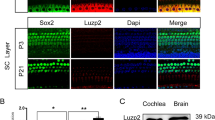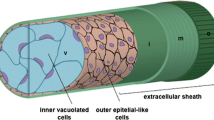Abstract
Early regionalized gene expression patterns within the otocyst appear to correlate with and contribute to development of mature otic structures. In the chick, the transcription factor Pax2 becomes restricted to the dorsal and entire medial side of the otocyst by stage 16/17. The dorsal region of the otocyst forms the endolymphatic duct and sac (ED/ES), and the cochlear duct is derived from the ventromedial region. In the mouse, however, Pax2 expression is reported only in the ventromedial and not the dorsal otocyst. In Pax2 null mice, the cochlea is missing or truncated, but vestibular structures differentiate normally. Here we demonstrate that in the chick, the emerging ED/ES express high levels of Pax2 even when the position of the emerging ED is altered with respect to its environment, either by 180° otocyst rotations about the anterior/posterior axis or transplantation of the otocyst into the hindbrain cavity. However, the Pax2 expression pattern is plastic in the rest of the otic epithelium after 180° rotation of the otocyst. Pax2 is upregulated on the medial side (formerly lateral), and downregulated on the lateral side (formerly medial and expressing Pax2) indicating that Pax2 expression is influenced by the environment. Although Pax2 is upregulated in the epithelium after 180° rotations in the region that should form the cochlear duct, cochlear ducts are truncated or absent, and the ED/ES emerge in a new ventrolateral position. Ablation of the hindbrain at the placode or early otic pit stage alters the timing of regionalized Pax2 expression in the otocyst. The resulting otocysts and ears are generally smaller, vestibular structures are abnormal, ED/ES are missing but cochlear ducts are of normal length. The hindbrain and dorsal periotic mesenchyme provide unique trophic and patterning information to the dorsal otocyst. Our results demonstrate that the ED is the earliest structure patterned in the inner ear and that the hindbrain is important for its specification. We also show that, although normal Pax2 expression is required for cochlear duct development, it is downstream of ventral otocyst patterning events.
Similar content being viewed by others
References
Barald, K. F., Lindberg, K. H., Hardiman, K., Kavka, A. I., Lewis, J. E., Victor, J. C., Gardner, C. A.& Poniatowski, A.(1997) Immortalized cell lines from embryonic avian and murine otocysts:Tools for molecular studies of the developing inner ear. International Journal of Developmental Neuroscience 15, 523–540.
Bartolami, S., Goodyear, R.& Richardson, G.(1991) Appearance and distribution of the 275 kD hair cell antigen during development of the avian inner ear. Journal of Comparative Neurology 314, 777–788.
Bissonnette, J. P.& Fekete, D. M.(1996) Standard atlas of the gross anatomy of the developing inner ear of the chicken. Journal of Comparative Neurology 368, 620–630.
Bockman, D. E., Redmond, M. E., Waldo, K., Davis, H.& Kirby, M. L.(1987) Effect of neural crest ablation on development of the heart and arch arteries in the chick. American Journal of Anatomy 180(4), 332–341.
Burri, M., Tromvoukis, Y., Bopp, D., Frigerio, G.& Noll, M.(1989) Conservation of the paired domain in metazoans and its structure in three isolated human genes. EMBO 8, 1183–1190.
Cable, J., Huszar, D., Jaenisch, R.& Steel, K. P.(1994) Effects of mutations at theWlocus (c-kit) on inner ear pigmentation and function in the mouse. Pigment Cell Research 7, 17–32.
Cable, J., Jackson, I. J.& Steel, K. P.(1995) Mutations at theWlocus affect survival of neural crest-derived melanocytes in the mouse. Mechanisms of Development 50, 139–150.
Chalepakis, G., Wijnholds, J.& Gruss, P.(1994) Pax-3-DNA interaction: Flexibility in the DNA binding and induction ofDNA conformational changes by paired domains. Nucleic Acids Research 223131–3137.
Chisaka, O., Musci, T.& Capecchi, M.(1992) Developmental defects of the ear, cranial nerves and hindbrain resulting from targeted disruption of the mouse homeobox gene Hox-1.6. Nature 355, 516–520.
Dahl, E., Koseki, H.& Balling, R.(1997) Pax genes and organogenesis. Bioessays 19, 755–765.
Deol, M. S.(1964) The abnormalities of the inner ear in kreisler mice. Journal of Embryology and Experimental Morphology 12, 475–490.
Dressler, G. R., Chowdhury, K., Nornes, H. O.& Gruss, P.(1990) Pax2, a new murine paired-boxcontaining gene and its expression in the developing excretory system. Development 109, 787–795.
Dressler, G. R.& Douglass, E. C.(1992) Pax-2 is a DNA-binding protein expressed in embryonic kidney and Wilms tumor. Proceedings of the National Academy of Sciences (USA) 89, 179–183.
Dressler, G. R.& Gruss, P.(1988) Do multigene families regulate vertebrate development? Trends in Genetics 4, 214–219.
Dressler, G. R., Wilkinson, J. E., Rothenpieler, U. W., Patterson, L. T., Williams-Simons, L.& Westphal, H.(1993) Deregulation of Pax2expression in transgenic mice generates severe kidney abnormalities. Nature 362, 65–67.
Fekete, D.(1996) Cell fate specification in the inner ear. Current Opinion in Neurobiology 6, 533–541.
Fekete, D.(1999) Development of the vertebrate ear: Insights from knockouts and mutants. Trends in Neuroscience 23, 263–269.
Fell, H. B.(1928) The development in vitroof the isolated otocyst of the embryonic fowl. Archaiv Experimentell Zellforschung 7, 69–81.
Fritzsch, B. F., Barald, K. F.& Lomax, M. I.(1997) Early embryology of the vertebrate ear. In Development of the Auditory System(edited by Rubel, E. W., Popper, A. N.& Fay, R. R.) pp. 80–145. New York: Springer Verlag.
Frohman, M. A., Martin, G. R., Cordes, S. P., Halamek, L. P.& Barsh, G. S.(1993) Altered rhombomere-specific gene expression and hyoid bone differentiation in the mouse segmentation mutant, kreisler (kr). Development 117, 925–936.
Gardner, C. A.& Barald, K. F.(1991) The cellular environment controls the expression of engrailed-like protein in the cranial neuroepithelium of quail/chick chimeric embryos. Development 113, 1037–1048.
Gerlach, L. M., Hutson, M. R., Germiller, J. A., Nguyen-Luu, D., Victor, J. C.& Barald, K. F.(2000) Addition of theBMP4antagonist, noggin, disrupts avian inner ear development. Development 127, 45–54.
Goodyear, R., Holley, M.& Richardson, G.(1994) Hair and supporting-cell differentiation during the development of the avian inner ear. Journal of Comparative Neurology 351, 81–93.
Goulding, M., Lumsden, A.& Gruss, P.(1993) Signals from the notochord and floor plate regulate the region-specific expression of two PAX genes in the developing spinal cord. Development 117, 1001–1016.
Hamburger, V.& Hamilton, V.(1951) A series of normal stages in the development of the chick embryo. Journal of Morphology 88, 49–92.
Harrison, R. G.(1936) Relations of symmetry in the developing ear of Amblystoma punctatum. Proceedings of the National Academy of Science USA 22, 238–247.
Harrison, R. G.(1945) Relations of symmetry in the developing embryo. Transactions of the Connecticut Academy of Arts and Sciences 36, 277–330.
Herbrand, H., Guthrie, S., Hadrys, T., Hoffmann, S., Arnold, H. H., Rinkwitzbrandt, S.& Bober, E.(1998) Two regulatory genes, cNkx5.1 and cPax2, show different responses to local signals during otic placode and vesicle formation in the chick embryo. Development 125, 645–654.
Kessel, M.& Gruss, P.(1990) Murine developmental control genes. Science 249, 374–379.
Ledouarin, N. M.(1982) The Neural Crest. London: Cambridge University Press.
Lewis, J. E., Victor, J. C., Lindberg, K. H.& Barald, K. F.(1996) Comparison of BMP-4 vs. Pax-2 expression during chick inner ear development. Cell autonomy vs. environmental influences on gene expression. Molecular Biology of the Cell 3, 214a.
Lindberg, K. H., Van De Ryt, J. T., Dressler, G. R.& Barald, K. F.(1995) The cellular environment controls the expression of Pax2 protein in the otocyst during development of the chick inner ear. In The Molecular Biology of Hearing and Deafness, Meeting, Bethesda MD.
Lufkin, T., Dierich, A., Lemeur, M., Mark, M.& Chambon, P.(1991) Disruption of the Hox-1.6 homeobox gene results in defects in a region corresponding to its rostral domain of expression. Cell 66, 1105–1119.
Mahmood, R., Flanders, K. C.& Morriss Kay, G. M.(1992) Interactions between retinoids and TGF betas in mouse morphogenesis. Development 115, 6774.
Mahmood, R., Kiefer, P., Guthrie, S., Dickson, C.& Mason, I.(1995) Multiple roles for FGF3 during cranial neural development in the chicken. Development 121, 1399–1410.
Mansour, S. L., Goddard, J. M.& Capecchi, M. R.(1993) Mice homozygous for a targeted disruption of the protooncogene int2have developmental defects in the tail and inner ear. Development 117, 13–28.
Manzanares, M., Trainor, P. A., Nonchev, S., Ariza-Mcnaughton, L., Brodie, J., Gould, A., Marshall, H., Morrison, A., Kwan, C. T., Sham, M. H., Wilkinson, D. G.& Krumlauf, R.(1999) The role of kreisler in segmentation during hindbrain development. Developmental Biology 211, 220–237.
Mark, M., Lufkin, T., Vonesch, J. L., Ruberte, E., Olivo, J. C., Dolle, P., Gorry, P., Lumsden, A.& Chambon, P.(1993) Two rhombomeres are altered in Hoxa-1 mutant mice. Development 119, 319–338.
Martin, P.& Swanson, G. J.(1993) Descriptive and experimental analysis of the epithelial remodellings that control semicircular canal formation in the developing mouse inner ear. Developmental Biology 159, 549–558.
Mayordomo, R., Rodriguez-Gallardo, L.& Alvarez, I. S.(1998) Morphological and quantitative studies in the otic region of the neural tube in chick embryos suggest a neuroectodermal origin for the otic placode. Journal of Anatomy 193, 35–48.
Meyer Zum Gottesberge, A.(1995) Calcium dependent intercellular interaction of the neural crest derivatemelanocytes and the epithelial cells of the vestibular organ. Acta Oto-Laryngologica Supplement 520, 360–361.
Noll, M.(1993) Evolution and role of Pax genes. Current Opinion in Genetics and Development 3, 595–605.
Nornes, H. O., Dressler, G. R., Knapik, E. W., Deutsch, U.& Gruss, P.(1990) Spatially and temporally restricted expression of Pax2 during murine neurogenesis. Development 109,797–809.
Represa, J., Leon, Y., Miner, C.& Giraldez, F.(1991) The int2proto-oncogene is responsible for induction of the inner ear. Nature 353, 561–563.
Rinkwitz-Brandt, S., Arnold, H. H.& Bober, E.(1996) Regionalized expression of Nkx5.1, Pax2 and sek genes during mouse inner ear development. Hearing Research 99, 129–138.
Rinkwitz-Brandt, S., Justus, M., Oldenettel, I., Arnold, H. H.& Bober, E.(1995) Distinct temporal expression of mouse Nkx-5.1 and Nkx-5.2 homeobox genes during brain and ear development. Mechanisms of Development 52, 371–381.
Stapleton, P., Weith, A., Urbanek, P., Kozmik, Z.& Busslinger, M.(1993) Chromosomal localization of seven PAX genes and cloning of a novel family member, PAX-9. Nature Genetics 3, 292–298.
Stoykova, A.& Gruss, P.(1994) Roles of Pax-genes in developing and adult brain as suggested by expression patterns. Journal of Neuroscience 14, 1395–1412.
Tannahill, D., Isaacs, H. V., Close, M. J., Peters, G.& Slack, J. M. W.(1992) Developmental expression of the Xenopus int2(FGF3) gene: Activation by mesodermal and neural induction. Development 115, 695–702.
Terzic, J., Muller, C., Gajovic, S.& Saragababic, M.(1998) Expression of Pax2 gene during human development. International Journal of Developmental Biology 42, 701–707.
Torres, M.& Giraldez, F.(1998) The development of the vertebrate inner ears. Mechanisms of Development 71, 5–21.
Torres, M., Gomez-Pardo, E.& Gruss, P.(1996) Pax2 contributes to inner ear patterning and optic nerve trajectory. Development 122, 3381–3391.
Walther, C., Guenet, J. L., Simon, D., Deutsch, U., Jostes, B., Goulding, M., Plachov, D., Balling, R.& Gruss, P.(1991) Pax:Amurine multigene family of paired box-containing genes. Genomics 11, 424–434.
Wu, D. K., Nunes, F. D.& Choo, D.(1998) Axial specification for sensory organs versus non-sensory structures of the chicken inner ear. Development 125, 11–20.
Wu, D. K.& Oh, S. H.(1996) Sensory organ generation in the chick inner ear. Journal of Neuroscience 16, 6454–6462.
Yntema, C. L.(1933) Experiments on the determination of the ear ectoderm of Amblystoma punctatum. Journal of Experimental Zoology 65, 317–357.
Yntema, C. L.(1939) Self-differentiation of heterotopic ear ectoderm in the embryo of Amblystoma punctatum. Journal of Experimental Zoology 80, 1–17.
Author information
Authors and Affiliations
Rights and permissions
About this article
Cite this article
Hutson, M.R., Lewis, J.E., Nguyen-Luu, D. et al. Expression of Pax2 and patterning of the chick inner ear. J Neurocytol 28, 795–807 (1999). https://doi.org/10.1023/A:1007057719025
Issue Date:
DOI: https://doi.org/10.1023/A:1007057719025




